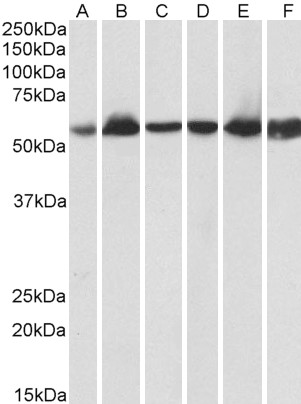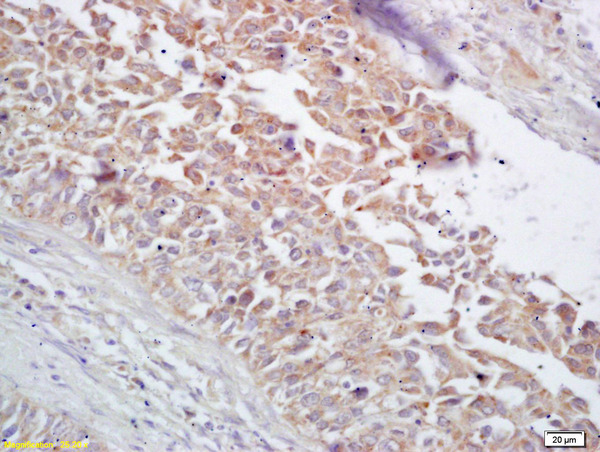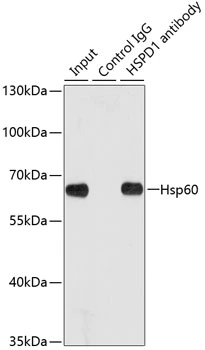HSP60 antibody
GTX110089
ApplicationsImmunoFluorescence, Western Blot, ELISA, ImmunoCytoChemistry, ImmunoHistoChemistry, ImmunoHistoChemistry Paraffin
Product group Antibodies
ReactivityDrosophila, Hamster, Human, Mouse, Rat, Zebra Fish
TargetHSPD1
Overview
- SupplierGeneTex
- Product NameHSP60 antibody
- Delivery Days Customer9
- Application Supplier NoteWB: 1:5000-1:20000. ICC/IF: 1:100-1:1000. IHC-P: 1:100-1:1000. *Optimal dilutions/concentrations should be determined by the researcher.Not tested in other applications.
- ApplicationsImmunoFluorescence, Western Blot, ELISA, ImmunoCytoChemistry, ImmunoHistoChemistry, ImmunoHistoChemistry Paraffin
- CertificationResearch Use Only
- ClonalityPolyclonal
- Concentration0.3 mg/ml
- ConjugateUnconjugated
- Gene ID3329
- Target nameHSPD1
- Target descriptionheat shock protein family D (Hsp60) member 1
- Target synonymsCPN60, GROEL, HLD4, HSP-60, HSP60, HSP65, HuCHA60, SPG13, 60 kDa heat shock protein, mitochondrial, 60 kDa chaperonin, P60 lymphocyte protein, chaperonin 60, epididymis secretory sperm binding protein, heat shock 60kDa protein 1 (chaperonin), heat shock protein 65, heat shock protein family D member 1, mitochondrial matrix protein P1, short heat shock protein 60 Hsp60s1
- HostRabbit
- IsotypeIgG
- Protein IDP10809
- Protein Name60 kDa heat shock protein, mitochondrial
- Scientific DescriptionThis gene encodes a member of the chaperonin family. The encoded mitochondrial protein may function as a signaling molecule in the innate immune system. This protein is essential for the folding and assembly of newly imported proteins in the mitochondria. This gene is adjacent to a related family member and the region between the 2 genes functions as a bidirectional promoter. Two pseudogenes, both located on chromosome 8, have been associated with this gene. Two transcript variants encoding the same protein have been identified for this gene. Mutations associated with this gene cause autosomal recessive spastic paraplegia 13. [provided by RefSeq]
- ReactivityDrosophila, Hamster, Human, Mouse, Rat, Zebra Fish
- Storage Instruction-20°C or -80°C,2°C to 8°C
- UNSPSC12352203
References
- Cox AR, Masschelin PM, Saha PK, et al. The rheumatoid arthritis drug auranofin lowers leptin levels and exerts antidiabetic effects in obese mice. Cell Metab. 2022,34(12):1932-1946.e7. doi: 10.1016/j.cmet.2022.09.019Read this paper
- Chen KC, Chen CR, Chen CY, et al. Bicalutamide Exhibits Potential to Damage Kidney via Destroying Complex I and Affecting Mitochondrial Dynamics. J Clin Med. 2021,11(1). doi: 10.3390/jcm11010135Read this paper
- Osuru HP, Paila U, Ikeda K, et al. Anesthesia-Sepsis-Associated Alterations in Liver Gene Expression Profiles and Mitochondrial Oxidative Phosphorylation Complexes. Front Med (Lausanne). 2020,7:581082. doi: 10.3389/fmed.2020.581082Read this paper
- Lin TY, Hua WJ, Yeh H, et al. Functional proteomic analysis reveals that fungal immunomodulatory protein reduced expressions of heat shock proteins correlates to apoptosis in lung cancer cells. Phytomedicine. 2021,80:153384. doi: 10.1016/j.phymed.2020.153384Read this paper
- Pérez-Rodriguez S, de Jesús Ramírez-Lira M, Wulff T, et al. Enrichment of microsomes from Chinese hamster ovary cells by subcellular fractionation for its use in proteomic analysis. PLoS One. 2020,15(8):e0237930. doi: 10.1371/journal.pone.0237930Read this paper
- Naeem S, Qi Y, Tian Y, et al. NIX compensates lost role of parkin in cd-induced mitophagy in HeLa cells through phosphorylation. Toxicol Lett. 2020,326:1-10. doi: 10.1016/j.toxlet.2020.03.001Read this paper
- Chernis N, Masschelin P, Cox AR, et al. Bisphenol AF promotes inflammation in human white adipocytes. Am J Physiol Cell Physiol. 2020,318(1):C63-C72. doi: 10.1152/ajpcell.00175.2019Read this paper
- Mallach A, Weinert M, Arthur J, et al. Post mortem examination of Parkinson's disease brains suggests decline in mitochondrial biomass, reversed by deep brain stimulation of subthalamic nucleus. FASEB J. 2019,33(6):6957-6961. doi: 10.1096/fj.201802628RRead this paper
- De Maio F, Battah B, Palmieri V, et al. PE_PGRS3 of Mycobacterium tuberculosis is specifically expressed at low phosphate concentration, and its arginine-rich C-terminal domain mediates adhesion and persistence in host tissues when expressed in Mycobacterium smegmatis. Cell Microbiol. 2018,20(12):e12952. doi: 10.1111/cmi.12952Read this paper
- Liu YH, Weng YP, Tsai HY, et al. Aqueous extracts of Paeonia suffruticosa modulates mitochondrial proteostasis by reactive oxygen species-induced endoplasmic reticulum stress in pancreatic cancer cells. Phytomedicine. 2018,46:184-192. doi: 10.1016/j.phymed.2018.03.037Read this paper





![IHC-P analysis of human breast carcinoma tissue using GTX25478 HSP60 antibody [4B9/89]. Left : Primary antibody Right : Negative control without primary antibody Antigen retrieval : heat induced antigen retrieval was performed using 10mM sodium citrate (pH6.0) buffer, microwaved for 8-15 minutes Dilution : 1:50](https://www.genetex.com/upload/website/prouct_img/normal/GTX25478/GTX25478_1292_IHC-P_w_23060722_302.webp)
![IHC-P analysis of human breast carcinoma tissue using GTX25479 HSP60 antibody [2E1/53]. Left : Primary antibody Right : Negative control without primary antibody Antigen retrieval : heat induced antigen retrieval was performed using 10mM sodium citrate (pH6.0) buffer, microwaved for 8-15 minutes Dilution : 1:20](https://www.genetex.com/upload/website/prouct_img/normal/GTX25479/GTX25479_1295_IHC-P_w_23060722_125.webp)

![FACS analysis of paraformaldehyde-fixed HeLa cells using GTX34785 HSP60 antibody [LK1]. Blue : Primary antibody Red : Isotype control](https://www.genetex.com/upload/website/prouct_img/normal/GTX34785/GTX34785_20200115_FACS_1653_w_23060801_985.webp)